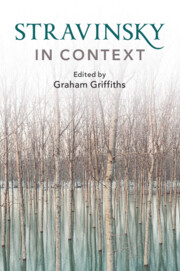Book contents
- Stravinsky in Context
- Composers in Context
- Stravinsky in Context
- Copyright page
- Contents
- Illustrations
- Contributors
- Preface
- Abbreviations
- Frontispiece
- Epigraph
- Part I Russia and Identity
- Part II Stravinsky and Europe
- Part III Partnerships and Authorship
- Part IV Performance and Performers
- Chapter 17 Challenges to Realism and Tradition: Stravinsky’s Modernist Theatre
- Chapter 18 Igor Stravinsky and Ballet as Modernism
- Chapter 19 Stravinsky’s Ear for Instruments
- Chapter 20 Towards a Conductor-Proof Ideal
- Chapter 21 The Pianist in the Recording Studio: Reimagining Interpretation
- Chapter 22 The Legacy of Stravinsky as Recorded History
- Part V Aesthetics and Politics
- Part VI Reception and Legacy
- Recommendations for Further Reading and Research
- Index
- Endmatter
Chapter 19 - Stravinsky’s Ear for Instruments
from Part IV - Performance and Performers
Published online by Cambridge University Press: 03 December 2020
- Stravinsky in Context
- Composers in Context
- Stravinsky in Context
- Copyright page
- Contents
- Illustrations
- Contributors
- Preface
- Abbreviations
- Frontispiece
- Epigraph
- Part I Russia and Identity
- Part II Stravinsky and Europe
- Part III Partnerships and Authorship
- Part IV Performance and Performers
- Chapter 17 Challenges to Realism and Tradition: Stravinsky’s Modernist Theatre
- Chapter 18 Igor Stravinsky and Ballet as Modernism
- Chapter 19 Stravinsky’s Ear for Instruments
- Chapter 20 Towards a Conductor-Proof Ideal
- Chapter 21 The Pianist in the Recording Studio: Reimagining Interpretation
- Chapter 22 The Legacy of Stravinsky as Recorded History
- Part V Aesthetics and Politics
- Part VI Reception and Legacy
- Recommendations for Further Reading and Research
- Index
- Endmatter
Summary
Do you remember the first time you heard the music of Igor Stravinsky? Or modernist music? My own teenage introduction to both was Ragtime (1917–18), our music teacher helping us join the dots between its particular strand of twentieth-century classical music and Scott Joplin’s evergreen rag, ‘The Entertainer’ (1902), which the pianists among us would struggle to play.1 Looking back, the muffled giggling which Ragtime provoked was due as much to the jolting introduction of its faint and weird-sounding cimbalom as to the relentless discontinuities that shape its phrasing, melody and timbre. To hear Stravinsky repeatedly is to understand how these innovations relate to one another, but the shock of having to process his music for the first time was real and literally physical. Here were strange folk- and jazz-inspired sounds, far removed from the Classical and Romantic orchestras that had framed our expectations of so-called classical music until that point. Ragtime’s sound was, and remains, quite alien.
- Type
- Chapter
- Information
- Stravinsky in Context , pp. 170 - 178Publisher: Cambridge University PressPrint publication year: 2020



